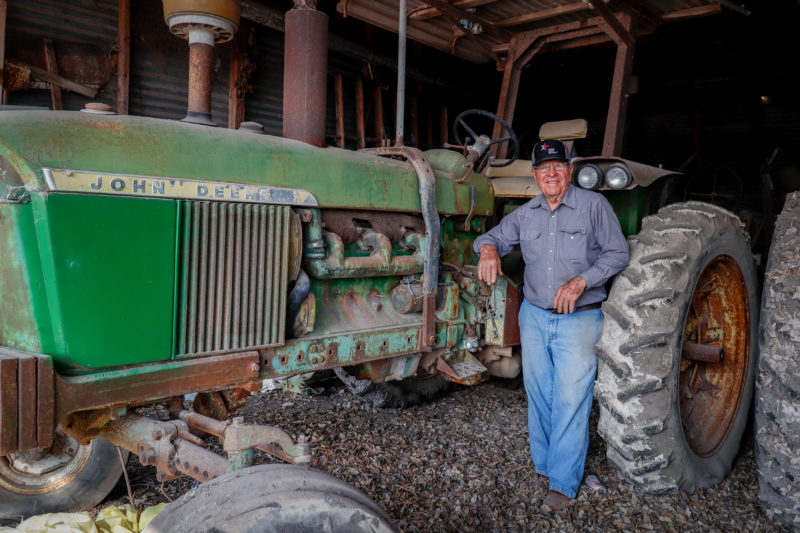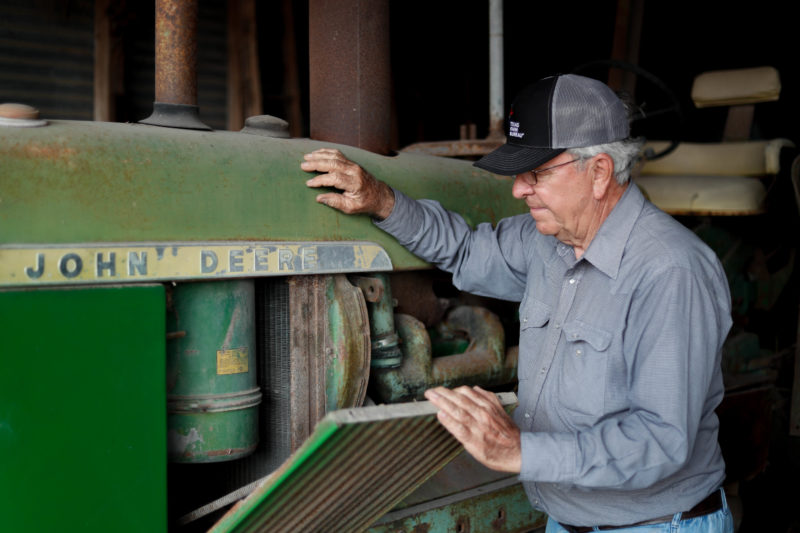Tractor Innovation Comes at Cost to Texas Farmers
By Gabriella Ybarra
Reporting Texas

South Texas cotton and grain farmer Bobby Nedbalek stands in front of his 1960s-era John Deere 4020 tractor on March 5 in Sinton. This was the first tractor Nedbalek ever purchased. Blaine Young/Reporting Texas
South Texas cotton and grain farmer Bobby Nedbalek remembers the day he purchased his first tractor in the 1960s — a brand new John Deere 4020 for only $8,000.
Although the tractor could only plow 30 acres a day and didn’t have air conditioning, a cabin or modern features like auto steering and GPS navigation, the machinery worked like a charm and could easily be taken apart and repaired.
“By today’s standards, you would call it almost crude. It was very simple stuff,” said Nedbalek, a former John Deere employee.
Today’s high-tech tractors are more productive than farmers could have ever imagined, but they come with a downside. Repairing them is no longer easy or cheap.
Major tractor manufacturers do not provide all the materials or software to allow farmers or independent mechanics to fix highly advanced tractors, leaving farmers reliant on company-authorized mechanics, which can be costly and time-consuming.
Farmers are seeking greater ability to make repairs themselves — part of a much broader “right to repair” movement.
The U.S. Public Interest Research Group, a nonprofit focusing on consumer issues, lists “right to repair” as one of its priorities and has been working to change state laws.
The movement gained steam last year after repair activists pressured Apple to reverse its restrictive repair policies. In a huge shift, Apple announced in November that it would be introducing a self-repair program, making tools, parts and manuals available to its customers.
“We’re seeing this across all sorts of product categories, whether it’s tractors, smartphones, ventilators or dishwashers,” said Kevin O’Reilly, director for the U.S. PIRG campaign for the “right to repair.” “The implementation of software into these products, allows manufacturers to lock consumers out of fixing their own stuff and control the repair of those devices.

Bobby Nedbalek walks in his field on March 5 in Sinton. Nedbalek said he hasn’t been able to plant his crops during the normal timeframe due to current weather conditions. Blaine Young/Reporting Texas
Billy Bob Brown, a cotton and grain farmer in Amarillo, said he spends nearly $80,000 a year trying to maintain his John Deere tractors.
“If I don’t get a bill from John Deere every month, it’s a miracle,” Brown said.
When his tractor won’t start, Brown said, a dial will reveal a code that tells him what’s wrong. But because he doesn’t know what the code means, he has to contact John Deere to have a licensed mechanic visit his farm, which can sometimes take days.
Most of the time, he says, the problem is minor or there’s no problem at all.
“They’ll come out and tell me there’s actually nothing wrong and your machine is good to go, and by the way that will be $400 for us coming out,” Brown said.
A John Deere tractor can have as many as 125 software-connected sensors, according to a report by U.S. PIRG. Each of these sensors is connected to a controller network. An issue with any of them will require diagnostic tools not available to farmers. These sensors and the controller networks are the highest point of failure on John Deere tractors, according to U.S. PIRG.
O’Reilly says other tractor manufacturers have similar policies, but John Deere tends to draw the focus of “right to repair” advocates because of its large market share and technologically advanced equipment.
John Deere, which made a record $6 billion in 2021, is in the midst of an antitrust lawsuit filed in Chicago alleging that the company is monopolizing its repair industry. According to the business website Bloomberg, John Deere financial reports showed that its parts and services were three to six times more profitable than sales of original equipment.
O’Reilly said this means after making a sale, John Deere is essentially “renting” out the tractor to continue to draw out funds from farmers looking to repair equipment. He said the cost of labor can be upward of $150 an hour compared with $45 to $55 to work with an independent technician.
“When there’s no competition, when the manufacturer and the dealers are the only game in town, then farmers don’t have any choice. They’ve got to shell out whatever the dealer wants to charge them,” O’Reilly said.

Bobby Nedbalek shows some of the technology on a newer John Deere tractor on March 5 in Sinton. Blaine Young/Reporting Texas
In a statement to Reporting Texas, John Deere said the company plans to announce “enhancements” that address farmer’s issues with self-repair.
“John Deere supports a customer’s right to safely maintain, diagnose, and repair their own equipment. To facilitate this, Deere provides the tools, parts, information guides, training videos and manuals needed for farmers to work on their machines, including remote access for technicians to provide long-distance support,” John Deere said in the statement.
John Deere added that it does not support the right to modify tractor software due to “the risks associated with the safe operation of equipment, emissions compliance and engine performance.”
Jahmy Hindman, John Deere’s chief tech officer, told the Verge last year that interfering with the software in John Deere tractors could change the machine’s emissions, which are adjusted to comply with environmental regulations.
John Deere’s high-tech tractors make them some of the most productive on the market. Since their advancements, the company has shifted to employing more software development engineers than mechanical design engineers, Hindman told the Verge
But a study done by U.S. PIRG, showed that 77% of farmers chose to buy older-model tractors to avoid the software in newer equipment. In the Midwest, used 40-year-old tractors are selling at auctions for thousands of dollars. Brown, the cotton farmer from Amarillo, said he regrets not keeping his older tractors.
As one of the leading exporters of agricultural commodities, Texas plays a large role in meeting agricultural demand. Farmers say time plays a critical role in their harvests.

Bobby Nedbalek wears his Shoppa’s hat on March 5 in Sinton. Nedbalek used to work for John Deere. Blaine Young/Reporting Texas
Nedbalek said he keeps backup tractors if things were to ever go south.
“If there is a breakdown that cannot be repaired in a very short period of time, we don’t want to miss the chance to do the job that needs to be done at that time,” Nedbalek said.
Brown and Nedbalek said being able to diagnose equipment problems themselves could save money and time.
“That could perhaps speed up the repair and get us back in the field — because one thing to remember about agriculture — being timely is the most important thing because mother nature waits on no one,” Brown said.
“Right to repair” is not about the modification of tools but about providing farmers with the same tools John Deere technicians have, O’Reily said.
In early February, Sen. John Tester, D-Montana, introduced a bill in the U.S. Senate that would require tractor companies to make spare parts, instruction manuals and software codes publicly available. Last year, President Joe Biden signed an executive order to push the Federal Trade Commission to solve issues related to repair restrictions.
O’Reilly said he expects Tester’s bill to receive bipartisan support. A 2019 poll showed that 71% of Americans support right-to-repair.
“This is just a common sense, bipartisan, red, blue, purple issue that would do farmers well and consumers well for the broader campaign,” O’Reilly said.
Brown said he understands that as technology becomes more efficient, they are going to be more complicated. But if given enough freedom, he said farmers can figure them out just fine.
“Some of the mechanics on these newer tractors are like being a doctor — you simply have to know what to do. But it’s surprising if you got a little leeway of learning something about it, the things you can do. It’s amazing what you can learn working on your own equipment,” Brown said.

Bobby Nedbalek opens up his 1960s-era John Deere 4020 tractor on March 5 in Sinton. Older tractors such as this one can be easier and cheaper to repair than the modern, high-tech ones the John Deere produces now. Blaine Young/Reporting Texas